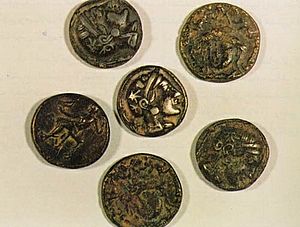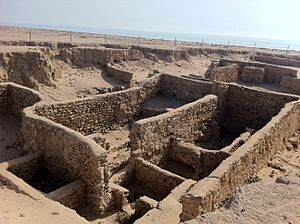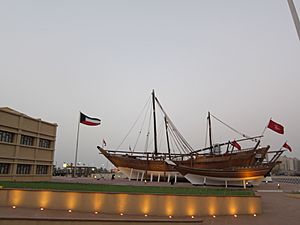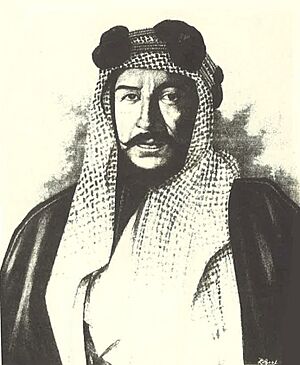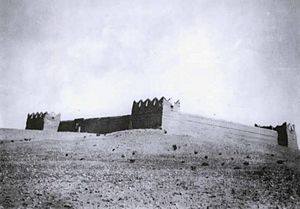History of Kuwait facts for kids
Kuwait is a country in Western Asia, located at the top of the Persian Gulf. People have lived in this area for a very long time because of its important location. Before oil was discovered, Kuwait was a busy trading port. In more recent times, Kuwait is well-known for the Gulf War (1990–1991).
Contents
Ancient Times in Kuwait
Early Settlements and Trade (8000 BC - 2000 BC)
After the ice age, the Tigris–Euphrates rivers created much of the land in what is now Kuwait. Some of the oldest signs of people living here date back to 8000 BC, where tools from the Stone Age were found in Burgan.
Around 6500 BC, during the Ubaid period, Kuwait was a key meeting point for people from Mesopotamia and Eastern Arabia. People in Kuwait at this time were among the first in the world to trade by sea. One of the earliest reed-boats ever found was discovered at site H3, dating back to the Ubaid period. Other ancient sites are in Khiran and Sulaibikhat.
Failaka Island and the Dilmun Civilization
Around 2000 BC, people from Mesopotamia first settled on Kuwait's Failaka Island. Traders from the Sumerian city of Ur lived on Failaka and ran businesses. The island had many buildings similar to those found in Iraq from that time.
From about 4000 BC to 2000 BC, the bay of Kuwait was home to the Dilmun civilization. This civilization included areas like Al-Shadadiya, Akkaz, Umm an Namil, and Failaka. Dilmun is mentioned in ancient Sumerian writings from around 3000 BC.
In the famous Mesopotamian story, the Epic of Gilgamesh, the hero Gilgamesh had to travel through mountains to reach Dilmun. Dilmun was sometimes called "the place where the sun rises" and "the Land of the Living." It was seen as a special place where creation happened.
Failaka Island was known as "Agarum" during the Dilmun era (from around 3000 BC). It was a major center for the Dilmun civilization. After Dilmun, Failaka was settled by the Kassites from Mesopotamia and was controlled by their kingdom. Many items found on Failaka are linked to Mesopotamian cultures.
Later, under Nebuchadnezzar II, the bay of Kuwait was controlled by Babylonia. Ancient writings found on Failaka show that Babylonians lived there. Failaka also had temples dedicated to Shamash, the Mesopotamian sun god.
Greek and Persian Influence
After a long period, the bay of Kuwait was settled again during the Achaemenid period (around 550–330 BC). In the 4th century BC, the ancient Greeks came to the bay of Kuwait under Alexander the Great. They called mainland Kuwait Larissa and Failaka Island Ikaros.
Alexander the Great named Failaka "Ikaros" because it looked like an island in the Aegean Sea. Greek myths mixed with local beliefs on Failaka. There was a temple to the goddess Artemis on the island during this time.
Archaeological finds show Greek settlements in Akkaz, Umm an Namil, and Subiya. Failaka was also a trading post for the kingdom of Characene. The Euphrates River used to flow directly into the Persian Gulf near northern Kuwait, about 15 kilometers from Failaka.
Later Empires and Early Islam
During the Achaemenid period, Failaka was controlled by the Achaemenid Empire. In 127 BC, Kuwait became part of the Parthian Empire. The kingdom of Characene was set up in what is now Kuwait, and their coins have been found in the area.
The earliest written mention of Kuwait was in 150 AD by the Greek scholar Ptolemy, who called the Bay of Kuwait Hieros Kolpos. In 224 AD, Kuwait became part of the Sassanid Empire and was known as Meshan.
In 636 AD, a major battle called the Battle of Chains took place in Kuwait near Kazma between the Sassanid Empire and the Rashidun Caliphate. The Rashidun Caliphate won, and the bay of Kuwait became home to the city of Kazma in the early Islamic era. This city was a trade port and a resting place for travelers.
Christian Nestorian communities also lived in the bay of Kuwait from the 5th to the 9th century. Remains of churches have been found in Akkaz and Al-Qusur.
Kuwait Before Oil (1500s - 1940s)
Portuguese Control and Early Growth (1521-1899)
In 1521, Kuwait was under Portuguese control. Later, in the 1700s, Kuwait City was a small fishing village ruled by local leaders from the Bani Khalid clan. Around the mid-1700s, the Bani Utbah group settled in Kuwait. They eventually took control, and Sabah I bin Jaber was chosen as their leader, usually dated to 1752.
A Thriving Trade Center (1760-1899)
In the late 1700s, Kuwait grew into an important trading hub for goods moving between India, Muscat, Baghdad, Persia, and Arabia. When the city of Basra was under siege by Persia (1775–1779), many Iraqi merchants moved to Kuwait. This helped Kuwait's boat-building and trading activities grow a lot.
Kuwait became known for building ships, and Kuwaiti vessels were famous across the Indian Ocean. Kuwait was also important in the horse trade, exporting many horses to India.
In 1896, Sheikh Muhammad Al-Sabah was killed by his half-brother, Mubarak. Mubarak then became the ruler.
Mubarak the Great (1897-1915)
Mubarak sought an alliance with the British, who saw this as a chance to limit German influence in the area. In January 1899, Mubarak signed an agreement with the British. This agreement meant Kuwait would not give land to other foreign powers without British permission, and Britain would handle Kuwait's foreign policy and national security. In return, Britain gave the ruling family an annual payment.
During Mubarak's rule, Kuwait was called the "Marseilles of the Persian Gulf" because its strong economy attracted many different people. The population was diverse, including Arabs, Persians, Africans, Jews, and Armenians. Kuwait was known for being open to different religions.
Wealthy trading families, who had been in Kuwait for a long time, formed an important group. They made their money from long-distance trade, shipbuilding, and pearling. They were well-traveled and educated their sons abroad.
World War I and Its Impact (1914-1921)
In 1913, the Anglo-Ottoman Convention of 1913 stated that Kuwait was an independent area within the Ottoman Empire, but its leaders were not fully independent.
During World War I, the ruler of Kuwait, Sheikh Mubarak Al-Sabah, helped the British by attacking Ottoman troops in nearby areas. Because of this, the British government recognized Kuwait as an "independent government under British protection." Mubarak then removed the Ottoman symbol from the Kuwaiti flag.
After World War I, the Kuwait–Najd War broke out (1919–21) due to the fall of the Ottoman Empire. This led to fights along the border.
Kuwait's economy declined greatly during this time, partly because of trade blockades and the worldwide Great Depression. International trade was a main source of income for Kuwait before oil. The pearling industry also collapsed because of the depression and the invention of cultured pearls by the Japanese.
Battle of Jahra (1920)
The Battle of Jahra was a key event during the Kuwait-Najd War. It happened on October 10, 1920, in Al Jahra, west of Kuwait City. A force of 4,000 Saudi Ikhwan attacked the Kuwait Red Fort, which was defended by 2,000 Kuwaiti men. The Kuwaitis were greatly outnumbered.
Defining Borders and Economic Hardship (1922-1939)
The British High Commissioner, Percy Cox, set the borders between Iraq, Kuwait, and Nejd in the Uqair Protocol of 1922. This decision limited Iraq's access to the Persian Gulf. Iraq's King Faisal I did not agree but had little choice as his country was under British control. The border was officially recognized again in 1932.
After the Uqair conference, Kuwait faced a Saudi trade blockade and occasional raids until 1937. Many merchant families left Kuwait in the early 1930s due to economic difficulties. When oil was discovered in 1937, most people in Kuwait were poor. The discovery of oil later helped the rulers become less dependent on the wealth of merchants.
From the 1930s, some Kuwaitis wanted Kuwait to reunite with Iraq. This led to the Free Kuwaiti Movement in 1938, which opposed British influence. The movement asked the Iraqi government for support. The Al Sabah family agreed to create a legislative council to address their demands. In 1938, the council voted for reunification with Iraq. In March 1939, a rebellion broke out, but the Al Sabah family, with British support, quickly stopped it.
Modern Kuwait (1946-Present)
Oil Wealth and Independence (1946-1989)
Between 1946 and 1982, Kuwait experienced a "golden era" of wealth thanks to oil. In 1946, crude oil was exported for the first time. By 1952, Kuwait became the largest oil exporter in the Persian Gulf. This growth attracted many foreign workers.
In June 1961, Kuwait became independent from British protection, and Sheikh Abdullah Al-Salim Al-Sabah became an Emir. Kuwait held its first parliamentary elections in 1963, becoming the first Arab state in the Persian Gulf to have a constitution and parliament.
Iraq initially did not recognize Kuwait's independence, claiming Kuwait was part of Iraq. However, after Britain and the Arab League supported Kuwait, Iraq backed down. A treaty of friendship was signed in 1963, and Iraq recognized Kuwait's 1932 border.
In the 1960s and 1970s, Kuwait was the most developed country in the region. It was the first Middle East country to save money from oil exports, creating the Kuwait Investment Authority. Kuwait University, founded in 1966, attracted students from neighboring countries. Kuwait's theatre industry was famous in the Arab world.
Kuwait's press was considered very free, and the country was a leader in Arab literature. Many writers and journalists moved to Kuwait for its strong freedom of expression laws. Kuwaiti society also became more open to Western ideas during this time.
In 1976, the emir temporarily suspended parts of the constitution and the assembly due to political disagreements. These were later brought back in 1980.
In the early 1980s, Kuwait faced economic challenges due to a stock market crash and lower oil prices. During the Iran–Iraq War, Kuwait supported Iraq. This led to some terror attacks in Kuwait, including bombings and attempts to harm the Emir.
In 1986, the constitution and National Assembly were suspended again. This led to a movement for democracy, which called for the return of constitutional rule.
The Gulf War (1990-1991)
Tensions grew between Iraq and Kuwait in the summer of 1990. Iraq accused Kuwait of stealing oil from a field near the border. Iraq also complained that Kuwait was producing too much oil, which lowered oil prices and hurt Iraq's economy.
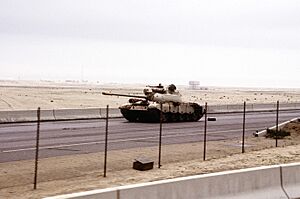
On August 2, 1990, Iraq invaded Kuwait and took control of the country. Iraq claimed it was supporting a rebellion against Kuwait's ruling family. An Iraqi-backed leader was put in charge of a "Provisional Government of Free Kuwait." Iraq officially took over Kuwait on August 8.
Kuwaiti civilians formed a local resistance movement against the Iraqi occupation. Many Kuwaitis fled the country to escape the conflict.
George H. W. Bush, the US President, condemned the invasion. The United Nations Security Council authorized an American-led group of 34 nations to fight the Gulf War to free Kuwait. Air attacks began on January 17, 1991. A ground attack started on February 23, 1991, and within four days, Iraqi forces were completely removed from Kuwait.
After the Gulf War (1992-2005)
After Kuwait was freed in 1991, the United Nations set the border between Iraq and Kuwait based on earlier agreements. In November 1994, Iraq officially accepted this border.
The Al Sabah family, Kuwait's ruling family, faced some criticism after the war for their actions during the Iraqi occupation. Many press restrictions were lifted in early 1992. The United States encouraged Kuwait to have a more democratic political system after its liberation.
In March 2003, Kuwait became a base for the US-led invasion of Iraq. About 100,000 US troops gathered in Kuwait before the invasion.
Recent Challenges (2006-Present)
Since 2006, Kuwait has faced ongoing political problems, including frequent changes in government. This has made it harder for Kuwait to attract investments and make economic changes, leaving the country very dependent on oil.
In January 2006, Emir Sheikh Jaber Al-Ahmed passed away. His successor, Sheikh Saad Al-Salim Al-Sabah, stepped down due to illness, and Sheikh Sabah Al-Ahmad Al-Jaber Al-Sabah became the new Emir. He appointed his half-brother, Sheikh Nawaf Al-Ahmad Al-Jaber Al-Sabah, as crown prince.
In August 2011, a major political corruption scandal emerged in Kuwait. In December 2013, there were claims of tapes showing discussions about plans to overthrow the government.
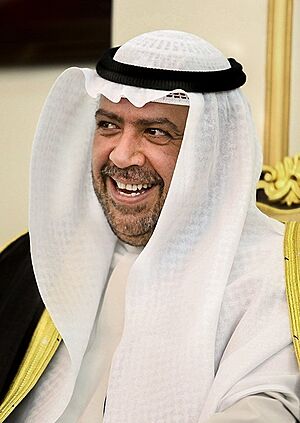
In March 2014, a US official accused Kuwait of funding terrorism. From 2014 to 2015, Kuwait was often described as a major source of funding for groups like ISIS and Al-Qaeda. The Kuwaiti government imposed a media ban on discussing this issue.
On June 26, 2015, a suicide bombing happened at a Shia Muslim mosque in Kuwait, killing 27 people. The Islamic State of Iraq and the Levant claimed responsibility.
In November 2018, Sheikh Ahmad Al-Fahad and others were charged in Switzerland with forgery related to a fake video. He denied wrongdoing.
The COVID-19 pandemic has made Kuwait's economic situation worse, leading to a large budget deficit. Kuwait's credit rating has been lowered because of falling oil revenue and slow economic changes. Kuwait is considered the most oil-dependent country in the region and has the weakest infrastructure among Gulf countries.
In September 2020, Sheikh Nawaf Al-Ahmad Al-Jaber Al-Sabah became the 16th Emir of Kuwait after the death of Emir Sheikh Sabah Al-Ahmad Al-Jaber Al-Sabah. In October 2020, Sheikh Mishal Al-Ahmad Al-Jaber Al-Sabah was appointed as the Crown Prince.
Since January 2021, Kuwait has been facing a significant political crisis and a potential debt crisis. In March 2021, a Kuwaiti court ordered the arrest of Sheikh Khaled Al Jarrah. In April 2021, former prime minister Sheikh Jaber Al-Mubarak Al-Hamad Al-Sabah was also detained on corruption charges.
In September 2021, a Swiss court found Sheikh Ahmed Al-Fahad guilty of forgery. He plans to appeal this decision. On December 16, 2023, Sheikh Mishal Al-Ahmad Al-Jaber Al-Sabah became the 17th Emir of Kuwait after the death of Nawaf Al-Ahmad Al-Jaber Al-Sabah.
See also
 In Spanish: Historia de Kuwait para niños
In Spanish: Historia de Kuwait para niños
- Mesopotamia
- Dilmun
- Timeline of Kuwait City
- List of museums in Kuwait


